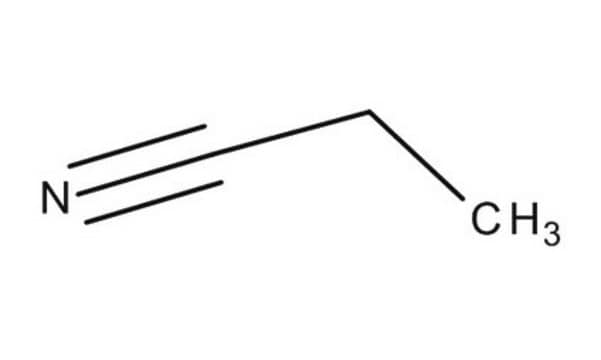76671
Propionitrile
analytical standard
Sinonimo/i:
Ethyl cyanide
About This Item
Prodotti consigliati
Grado
analytical standard
Livello qualitativo
Saggio
≥99.5% (GC)
Durata
limited shelf life, expiry date on the label
tecniche
HPLC: suitable
gas chromatography (GC): suitable
Indice di rifrazione
n20/D 1.366 (lit.)
n20/D 1.366
P. eboll.
97 °C (lit.)
Punto di fusione
−93 °C (lit.)
Densità
0.772 g/mL at 25 °C (lit.)
applicazioni
environmental
Formato
neat
Stringa SMILE
CCC#N
InChI
1S/C3H5N/c1-2-3-4/h2H2,1H3
FVSKHRXBFJPNKK-UHFFFAOYSA-N
Cerchi prodotti simili? Visita Guida al confronto tra prodotti
Categorie correlate
Applicazioni
Prodotti consigliati
Avvertenze
Danger
Indicazioni di pericolo
Classi di pericolo
Acute Tox. 2 Dermal - Acute Tox. 2 Oral - Acute Tox. 4 Inhalation - Eye Irrit. 2 - Flam. Liq. 2
Codice della classe di stoccaggio
3 - Flammable liquids
Classe di pericolosità dell'acqua (WGK)
WGK 1
Punto d’infiammabilità (°F)
42.8 °F - closed cup
Punto d’infiammabilità (°C)
6 °C - closed cup
Dispositivi di protezione individuale
Eyeshields, Faceshields, Gloves, type ABEK (EN14387) respirator filter
Choose from one of the most recent versions:
Possiedi già questo prodotto?
I documenti relativi ai prodotti acquistati recentemente sono disponibili nell’Archivio dei documenti.
Il team dei nostri ricercatori vanta grande esperienza in tutte le aree della ricerca quali Life Science, scienza dei materiali, sintesi chimica, cromatografia, discipline analitiche, ecc..
Contatta l'Assistenza Tecnica.







